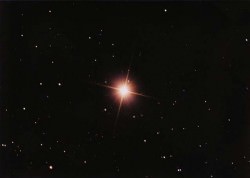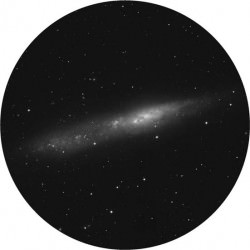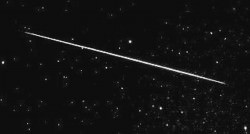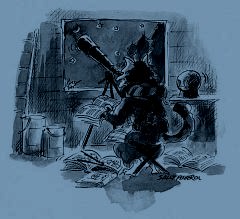Greetings, fellow SkyWatchers! We be down here, but not quite out. It’s going to be an awesome weekend with the Geminid meteor shower, dark skies and plenty of excitement to go around! Unfortunately, this kid is grounded – but don’t let a little “cold” stop you from enjoying the celestial sights! Whenever you’re ready… I’ll see you in the back yard!
 Friday, December 11, 2009 – On this date in 1863, Annie Jump Cannon was born. She was an American astronomer who created the modern system for classifying stars by their spectra. Tonight we celebrate this achievement.
Friday, December 11, 2009 – On this date in 1863, Annie Jump Cannon was born. She was an American astronomer who created the modern system for classifying stars by their spectra. Tonight we celebrate this achievement.
Come along with meand have a look at some very specific stars with unusual visual spectral qualities! Let’s grab a star chart, brush up on our Greek letters, and start first by returning to Mu Cephei. Nicknamed the ‘‘Garnet Star,’’ this is perhaps one of the reddest stars visible to the unaided eye. At around 1,200 light-years away, this spectral type M2 star will show a delightful blue-purple ‘‘flash.’’ If you still don’t perceive color, try comparing Mu to its bright neighbor Alpha, a spectral type A7, or ‘‘white,’’ star. Perhaps you’d like something a bit more off the beaten path? Then head for S Cephei, about halfway between Kappa and Gamma toward the pole. Its intense shade of red makes this magnitude 10 star an incredibly worthwhile hunt.
 To see an example of a B spectrum star, look no further than the Pleiades. All the components are blue-white. Want to taste an ‘‘orange?’’ Then look again at Aldebaran, or Alpha Tauri, and say hello to a K spectrum star. Now that we have your curiosity aroused, would you like to see what our own Sun would look like? Then choose Alpha Aurigae, better known as Capella, and discover a spectral class G star that’s ‘‘only’’ 160 times brighter than the one that holds our Solar System together! Still no luck in seeing color? Don’t worry. It does take a bit of practice! The cones in our eyes are the color receptors, and when we go out in the dark, the color-blind rods take over. By intensifying the starlight with either a telescope or binoculars, we can usually excite the cones in our dark-adapted eyes to respond to color.
To see an example of a B spectrum star, look no further than the Pleiades. All the components are blue-white. Want to taste an ‘‘orange?’’ Then look again at Aldebaran, or Alpha Tauri, and say hello to a K spectrum star. Now that we have your curiosity aroused, would you like to see what our own Sun would look like? Then choose Alpha Aurigae, better known as Capella, and discover a spectral class G star that’s ‘‘only’’ 160 times brighter than the one that holds our Solar System together! Still no luck in seeing color? Don’t worry. It does take a bit of practice! The cones in our eyes are the color receptors, and when we go out in the dark, the color-blind rods take over. By intensifying the starlight with either a telescope or binoculars, we can usually excite the cones in our dark-adapted eyes to respond to color.
Tonight is also the peak of the Sigma Hydrid meteor stream. Its radiant is near the head of the Serpent, and the fall rate is about 12 per hour—but these are fast! While you’re watching, check out the very close pairing of Spica and the Moon as they rise together. You’ll find the asteroid Ceres 8.7 degrees north of the lunar limb!
 Saturday, December 12, 2009 – Today we honor the birth of S.W. Burnham. Born in 1838, this American astronomer spent 50 years of his life surveying the night sky for double stars. Although at the time it was believed that all visual binaries had been accounted for, Burnham’s work was eventually published as the General Catalogue of 1,290 Double Stars. His keen eye and diligent study opened the doors for him at observatories such as Yerkes and Lick. His lifetime count of binaries discovered eventually reached 1,340. He was also the very first to observe what would eventually be termed a ‘‘Herbig–Haro object,’’ and he discovered 6 New General Catalog (NGCs) and 21 Index Catalog (IC) objects.
Saturday, December 12, 2009 – Today we honor the birth of S.W. Burnham. Born in 1838, this American astronomer spent 50 years of his life surveying the night sky for double stars. Although at the time it was believed that all visual binaries had been accounted for, Burnham’s work was eventually published as the General Catalogue of 1,290 Double Stars. His keen eye and diligent study opened the doors for him at observatories such as Yerkes and Lick. His lifetime count of binaries discovered eventually reached 1,340. He was also the very first to observe what would eventually be termed a ‘‘Herbig–Haro object,’’ and he discovered 6 New General Catalog (NGCs) and 21 Index Catalog (IC) objects.
Today in 1961, OSCAR 1 was launched. This name of this project, which started in 1960, stands for Orbital Satellite Carrying Amateur Radio. OSCAR 1 operated in orbit for 22 days, transmitting a signal in Morse code: the simple greeting ‘‘Hi.’’ The success of the mission helped to promote interest in amateur radio, which continues to this day!
 Let’s honor Burnham’s work and our summering southern friends once again as we head toward the incomparable NGC 55. Located about two finger-widths north-northwest of Alpha Phoenicis (RA 00 15 08 Dec –39 13 13), this large, near edge-on galaxy is truly a southern gem. At magnitude 7.8, this bright member of the Sculptor Galaxy group can easily be spotted in binoculars. Mid-sized scopes will
Let’s honor Burnham’s work and our summering southern friends once again as we head toward the incomparable NGC 55. Located about two finger-widths north-northwest of Alpha Phoenicis (RA 00 15 08 Dec –39 13 13), this large, near edge-on galaxy is truly a southern gem. At magnitude 7.8, this bright member of the Sculptor Galaxy group can easily be spotted in binoculars. Mid-sized scopes will
begin resolution of mottling in the structure, while large aperture will show individual stars, nebulous areas, and dark dust clouds—with a very prominent one east of the nucleus. Rock on. . .
Sunday, December 13, 2009 – Tonight we have the hauntingly beautiful and mysterious displays of the Geminid meteor shower. First noted in 1862, the stream was weak but has intensified with time. Around 10 years ago, observers recorded an outstanding 110 per hour during a moonless night. . .and we’ve got a moonless night.
 So why are the Geminids a mystery? Most meteor showers are cometary debris, documented and recorded for hundreds of years. When astronomers began looking for the Geminids’ parent comet, they found none. It wasn’t until 1983 that an object was detected matching the meteoroid stream. . .an asteroid. Originally designated as 1983 TB, but later renamed 3200 Phaethon, this apparently rocky Solar System member has a highly elliptical orbit, placing it within 0.15 Astronomical Unit (AU) of the Sun about every year and a half. But asteroids can’t fragment like comets—or can they? Phaethon may have collided with one or more asteroids in passing, creating rocky debris. Plausible, but the meteoroid ‘‘path’’ occurs when Phaethon nears the Sun—behaving like a comet, yet developing no tail.
So why are the Geminids a mystery? Most meteor showers are cometary debris, documented and recorded for hundreds of years. When astronomers began looking for the Geminids’ parent comet, they found none. It wasn’t until 1983 that an object was detected matching the meteoroid stream. . .an asteroid. Originally designated as 1983 TB, but later renamed 3200 Phaethon, this apparently rocky Solar System member has a highly elliptical orbit, placing it within 0.15 Astronomical Unit (AU) of the Sun about every year and a half. But asteroids can’t fragment like comets—or can they? Phaethon may have collided with one or more asteroids in passing, creating rocky debris. Plausible, but the meteoroid ‘‘path’’ occurs when Phaethon nears the Sun—behaving like a comet, yet developing no tail.
By studying the spectral signature of the Geminid meteor shower, scientists have determined that the fragments are denser than cometary material, yet not as dense as an asteroid. Phaethon may be an extinct comet that has gathered a thick layer of interplanetary dust during its travels yet retains the ice-like nucleus. Without physical samples of this ‘‘mystery,’’ we may never fully understand what Phaethon is, but we can fully appreciate the annual display it produces! Thanks to the wide path of the stream, folks the world over get an opportunity to enjoy the show. The traditional peak time is tonight as soon as the constellation of Gemini appears, around midevening. The radiant for the shower is near the bright star Castor, but meteors can originate from many points in the sky. From around 2:00 a.m. tonight until dawn (when our local sky window is aimed directly into the stream), it is possible to see about one ‘‘shooting star’’ every 30 seconds.
Enjoy the incredible and mysterious Geminids!
This week’s awesome images are (in order of appearance): Annie Jump Cannon (widely used public image), Aldebaran – credit: John
Chumack, S.W. Burnham (historical image). NGC 55 (credit—Palomar Observatory, courtesy of Caltech) and Geminid meteor (credit—NASA). We thank you so much!


Clouded out here with MUCH needed rain (No. Calif.).. so the Geminids will go by without me? BUT am listening to them anyway @: http://wowzaweb.streamguys.com/~spaceweather/
Its interesting to listen to the different radio/sound signatures of the individual meteors… most are simply a little ‘beep’ or ‘blip’, and yet some sound like an incoming missile or? and last quite a long time….